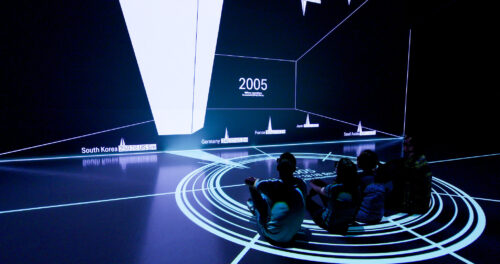Futurelab Day 2022
-

SonoSynthesis
Can Machines and Nature Co-Create Music?
In the new era of creative collaboration, can machines and nature co-create art and music? In the SonoSynthesis project, a team of researchers from the Ars Electronica Futurelab brought together AI, biology, and Deep Space technologies to develop an immersive audio and visual experience.
-

Life Ink
Human Creativity as Immersive 3D Ink
Can the human mind and body become a pen that generates ink to express our creativity? Life Ink explores the inner mechanism of creativity by visualizing brainwaves and body signals as immersive three-dimensional ink – lending color to our thoughts, feelings, and creative sparks.
-

Dataspace
Global impacts of the Russian war on Ukraine
What is truth, what is the role of journalism, and how can art and journalism contribute in a meaningful way in the midst of seemingly endless crises? Dataspace is a project that proposes a form of “newspaper of the future,” showcasing data on the profound impact of Russia’s war on Ukraine in the Ars Electronica…
-

WebExpression
Painting Our Hybrid Working World in Real-Time
A composition of strands, strings, and tones in an imaginary space makes up this vivid real-time painting to artistically interpret anonymized data of today’s hybrid working world.
-

Welcome to Planet B
A Children’s Pop-Up Book About Climate Change
The Futurelab application Welcome to Planet B brings climate decisions to Deep Space 8K. To translate the project to a child-friendly format for 8- to 12-year-olds, a team at the lab created a matching interactive pop-up book. It is designed to get kids excited about climate protection and to marvel, grasp and understand – and,…
-

CoBot Studio
As humans and robots work together ever more closely, their joint success is linked to certain preconditions: How do you create safe working environments? How can we increase the acceptance of robots in everyday work? And how do you communicate with a colleague who consists only of a gripper arm?